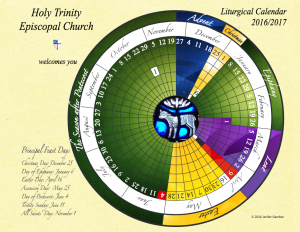
Why does the Church follow a different calendar than the rest of the world?
The patterns of our church calendar, based in liturgical seasons, frame our parish life. The repeating cycles of Advent, Christmas, Epiphany, Lent, Easter, and the Season after Pentecost, sprinkled with Holy Days and Feasts, connect the current year to all the years that have passed and all the years that have yet to come. The great gift of these cycles is that our finitude is woven into the eternal pattern.
We remember those celebrations of Christmas and Easter in years past that shaped our expectations for this year’s celebrations. This Christmas and this Easter will shape our expectations for celebrations to come. And so it goes.
We have now entered a new church year, the first full year of the church calendar that we will spend together. We also begin a new cycle in the lectionary, the readings set forth for each Sunday. We will work our way through the Gospel of Matthew in this Year A of the lectionary, and next year, Year B, we will find ourselves primarily in Mark’s Gospel. The following year, we’ll be back to the Gospel of Luke for Year C. And so it goes.
It is fitting, and an indication of the genius of the church calendar, that our church year begins with a season that layers the past, the present, and the future arrivals of our Lord Christ. We spend the darkening days of Advent waiting for the Light of the World to be born in a manger in Bethlehem. We pray as we light the candles on our Advent wreaths for Jesus to be present with us each day. We live in anticipation of the final coming of Christ. Barbara Brown Taylor says that “Ours may be the generation that finally sees [Jesus] ride in on the clouds, or we may meet him the same way generations before us have—one by one by one, as we close our eyes for the last time. Either way, our lives are in God’s hands. Either way, God leaves the living of them to us.”
Church time invites us to step out of the straightforward, linear march of secular history into the cyclical, multivalent dance between past, present, and future. We are always hearkening back to our Biblical roots hear the stories of how God’s loving-kindness creates, sustains, and nurtures us. We apply the lessons of those stories to the needs of our own time. We are reminded of our hope for the future–for creation and for ourselves. And so it goes, world without end.
